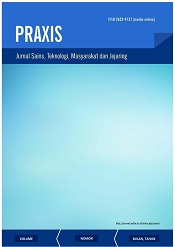Menerjemahkan Empati dan Penerimaan dalam Sesi Konseling
Abstract
Giving empathy and acceptance for clients is such an important technique that needs to be done by every counselors. Despite of the counselors’ psychological approach, empathy and acceptance are still mandatory skills that need to be mastered. While many references had cited the need to perform this skill, a detailed and practical example to do these skills is still rare to be found. This article reviews several references which show conversation between counselor and clients. One of the conversations chosen is a conversation by Carl Rogers in a Person-Centered counseling. The other conversation was done by Natalie Rogers in a Person-Centered Expressive Arts Therapy session. Following the conversations, explanation and analysis related the empathy and acceptance are given. The conversation samples given were categorized in four settings, which are (1) responding clients’ question, (2) giving response for clients’ blocking, (3) reflecting clients’ emotional story, and (4) reflecting clients’ emotional expression that was directed to counselor. The explanation showed that empathy and acceptance are difficult skills to be mastered. Nevertheless, those skills are still playing important roles in counselor sessions, especially when handling clients’ emotional condition.
Abstrak
Memberikan empati dan penerimaan kepada klien adalah hal yang sangat perlu untuk dilakukan oleh setiap konselor. Terlepas dari pendekatan apa yang dipakai, empati dan penerimaan tetap menjadi keterampilan utama yang perlu dimiliki. Berbagai sumber ajar mengenai empati dan penerimaan telah menuliskan mengenai konsep ini, namun uraian secara lebih terperinci mengenai penerapannya belumlah diberikan. Tulisan ini mengulas mengenai beberapa kajian yang memaparkan percakapan antara konselor dengan klien pada sesi konseling. Percakapan yang diulas adalah percakapan antara Carl Rogers dengan kliennya dalam sesi konseling Person-Centered, dan juga percakapan antara Natalie Rogers dengan kliennya dalam sesi terapi seni dengan pendekatan Person-Centered. Uraian mengenai konsep empati dan penerimaan diberikan penulis terkait dengan setiap contoh percakapan pada berbagai kondisi konseling yaitu (1) menanggapi pertanyaan klien, (2) memberikan respons terhadap blocking klien, (3) merefleksikan muatan emosi terhadap cerita klien, dan (4) merefleksikan muatan emosi klien yang ditujukan ke konselor. Pemaparan tersebut menunjukkan bahwa empati dan penerimaan merupakan keterampilan yang sulit tetapi sangat diperlukan, terutama menghadapi berbagai kondisi emosional klien
Keywords
Full Text:
PDFReferences
De Stefano, J., Mann-Feder, V., & Gazzola, N. (2010). A qualitative study of client experiences of working with novice counsellors. Counselling and Psychoterapy Research, 10, 2, 139-146.
Frankel, M., Rachlin, H., & Yip-Bannicq, M. (2012). How nondirective therapy directs: The power of empathy in the context of unconditional positive regard. Person-Centered & Experiential Psychotherapies, 11(3): 205-214.
Kim, S. (2010). A Story of a Healing Relationship: The Person-Centered Approach in Expressive Arts Therapy. Journal of Creativity in Mental Health, 5, 93-98.
Lewis, M.K., Rogers, C.R., & Shlien, J.M. (2008). Time-limited client-centered psychotherapy: One case. In Tudor, K. (editor). Brief Person-Centered Therapies. Los Angeles: Sage.
PsychotherapyNet. (2012, November 9). Expressive Arts Therapy Video with Natalie Rogers Video [Video file]. Retrieved from https://www.youtube.com/watch?v=sd62Al_NsYU
Rogers, C. (1980). A way of being. Boston: Houghon-Mifflin
Rogers, N., Tudor, K., Tudor, L. E., & Keemar, K. (2012). Person-centered expressive arts therapy: A theoretical encounter. Person-Centered & Experiential Psychotherapies, 11(1), 31–47. http://doi.org/10.1080/14779757.2012.656407
Satyajati, M.W. (2016). Person-Centered Expressive Arts Therapy untuk Meningkatkan Efikasi Diri Konselor Adiksi. Tesis (tidak dipublikasikan). Yogyakarta: Universitas Gadjah Mada.
Satyajati, M.W., & Iswari, R.D. (2015). Membebaskan Kritik Diri dengan Menggambar: Studi Kasus Terapi Seni berbasis Pendekatan Person-Centered pada Permasalahan Gangguan Panik. Prosiding Konferensi Nasional Pengkajian Seni: Arts and Beyond, halaman 459-475.
Singh, A.N., & Strand, P.S. (2008). A Person-Centered, strength-based treatment of aggression and sexually inappropriate behavior in mental health. Clinical Case Studies, 7 (5), 397-408, doi: 10.1177/1534650108316935
Ursano, R.J., Sonnenberg, M.D., & Lazar, S.G. (2004). Concise Guide to Psychodinamic Psychotherap: principles and techniques of brief, intermittent, and long-term psychodynamic psychotherapy. Arlington: American Psychiatric Publishing.
DOI: https://doi.org/10.24167/praxis.v2i1.2281
View My Stats | ISSN 2622-9137 (media online)







